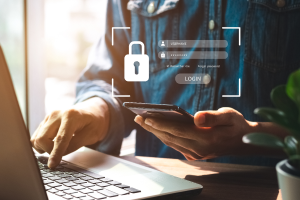While you can’t delete your personal info from the internet entirely, you can take strong steps to remove it from risky places where others could exploit it for profit or harm.
Why is it so important to take control of our personal info? Because so much of business, finance, healthcare, and life in general runs on data, your personal info has a dollar value attached to it.
For instance, personal info fuels targeted advertising and marketing campaigns, just as it helps adjusters set insurance rates and healthcare providers make projections about our well-being. Businesses want it for employment background checks. Law enforcement uses it to investigate persons of interest. Banks and credit card companies base their approvals on it. Of course, hackers, scammers, and thieves want to steal it too—to drain your accounts and wage other attacks on you.
The high value of your personal info makes a strong argument for controlling, as much as possible, what and where you share. In this article, we’ll show how easy it is to do by giving you tips on how to reduce your digital footprint on the internet and keep your identity private.
Why delete yourself from the internet?
Taking steps to delete yourself from the internet is one of the most powerful moves you can make to protect your privacy and security.
Every day, data brokers and people-search websites scrape public records and online activity to build a detailed profile of you that they can sell to anyone. This exposure increases your risk of identity theft, being targeted for scams, and even online harassment. For instance, a scammer could use your leaked address and phone number from a data broker site to target you with phishing attacks. Similarly, an old, embarrassing social media post could surface during a background check, impacting your career.
By removing your information from the internet, you reclaim control and empower yourself to manage your reputation, prevent your data from being misused, and significantly reduce unwanted digital noise.
Understand your digital shadow
Taking control of your personal info starts with a look at your digital shadow, also known as a digital or electronic footprint, which is the trail of data that you leave behind while engaging in online activities. This information includes your posts in forums and social media profiles, other people’s posts that mention you, your pictures in an online newsletter, your name listed in the standings of your co-ed soccer league, your bio on the company’s “About Us” page, and even online reviews you write. Your digital shadow grows larger as you say more things, and as others mention you online.
With the addition of public records, your shadow grows yet more. That might include your home mortgage payments, who lives there with you, your age, children, driving record, education, occupation, and estimated income. It all depends on where you live and what data regulations are in place there.
Some regions have stricter privacy rules than others when it comes to public records. For example, in the U.S., California, Virginia, Connecticut, Colorado, Utah, Iowa, Indiana, Tennessee, Oregon, Montana, Texas, and Delaware have strong data privacy laws. The European Union has the General Data Protection Regulation (GDPR).
Then there’s the hundreds of data points about you gathered and sold by online data brokers from private sources like supermarket club cards that track your shopping history, app developers and websites that sell info to anyone who’ll pay, including hackers, scammers, and spammers.
Finally, a sizable portion of your shadow comes from the deep web, which forms the 95% of the internet that’s not searchable. Any time you go through a paywall or use a password to access internet content, such as logging into your bank account, accessing medical records through your healthcare provider, using corporate web pages as part of your workday, or streaming a show—you’re entering the deep web. All the info that forms the basis of your credit score, health history, financial info, and the data that websites and advertisers capture about you online.
A subset of the deep web is the dark web. It’s not searchable as well, and requires a special browser to access. Some of the sites and data stores found there are entirely legitimate, questionable, or outright illegal. You’ll find dark marketplaces here where bad actors put up personal info for sale, even yours.
Everyone online indeed has a digital shadow, and some shadows are longer than others.
The importance of taking control
So, what’s the big deal? That’s how the internet works, right? That’s a fair question. Part of the answer comes down to how much you value your privacy. More importantly, keeping a lower online profile offers better protection from cybercrime.
Consider research published by the science journal National Library of Medicine in 2019, where the abstract states that:
“Using our model, we find that 99.98% of Americans would be correctly re-identified in any dataset using 15 demographic attributes. Our results suggest that even heavily sampled anonymized datasets are unlikely to satisfy the modern standards for anonymization set forth by GDPR [Europe’s General Data Protection Regulation] and seriously challenge the technical and legal adequacy of the de-identification release-and-forget model.”
This means that even though that data has been scrubbed to make the people in it anonymous, a hacker needs only 15 pieces of info to identify you for certain. From there, they could pinpoint any health conditions linked to you. That further strengthens the argument for taking control of your personal info.
Step-by-step guide: How to delete yourself from the internet
Now that you understand the importance of deleting your personal information from the internet, here is a detailed guide on how to go about this process:
- Conduct a digital footprint audit: Start by searching your name, email addresses, and phone numbers in various search engines. This initial audit helps you understand your public exposure and creates a baseline for your cleanup efforts.
- Delete or secure social media: Permanently delete accounts you no longer use. For those you keep, tighten privacy settings to limit what the public and search engines can see. McAfee Social Privacy Manager simplifies this by adjusting over 100 settings across platforms with just a few clicks.
- Be choosy about app permissions on your phones. Fewer apps mean fewer avenues of potential data collection. If you have old, unused apps, consider deleting them, along with the accounts and data linked with them.
- Purge old online accounts: Forgotten accounts on shopping sites, forums, and old web services are prime targets for data breaches. Tools like McAfee Online Account Cleanup can scan the web for your old accounts, show their risk level, and delete these liabilities.
- Target data broker and people-search sites: This is the most critical step for privacy. Manually sending opt-out requests is tedious and often temporary. Services like McAfee Personal Data Cleanup automate this process by finding your data, and sending removal requests on your behalf, with ongoing scans to ensure your personal information stays off these sites.
- Submit legal removal requests: With new privacy laws emerging, leverage your rights. Use official processes like Google’s “Results about you” tool and submit formal takedown notices under regulations like GDPR or California Consumer Privacy Act (CCPA) where applicable.
- Adopt proactive privacy tools: Prevent future data collection by making a bank-grade VPN encryption your default. A VPN encrypts your traffic and masks your IP address, making you harder to track.
- Establish continuous monitoring: Erasing yourself from the internet is an ongoing process. Regularly repeat these steps and use automated tools to monitor for new exposures to ensure your digital footprint stays minimal over the long term.
To give you a deeper understanding, here is a more detailed explanation of the impact of following the steps above:
Deleting or deactivating your social media accounts
- Deactivation: Your profile becomes invisible, but Facebook retains your data. You can reactivate anytime. Find this in Settings > Your Facebook Information > Deactivation and Deletion.
- Deletion: This is permanent. After a grace period (usually 30 days), your data is removed and unrecoverable. You can download a copy of your information before deletion via Settings > Your Facebook Information > Download Your Information.
- Privacy Impact: Deletion significantly reduces your discoverable footprint; deactivation is a temporary measure.
X (formerly Twitter):
- Deactivation: Your account is hidden for 30 days. If you don’t log in during this period, it’s permanently deleted. Go to Settings and privacy > Your account > Deactivate your account.
- Data download: You can request your archive via Settings and privacy > Your account > Download an archive of your data.
- Privacy Impact: Permanent deletion removes your tweets and profile information from X’s active servers.
Instagram (owned by Meta/Facebook):
- Deactivation: Hides your profile, photos, comments, and likes until you reactivate. This action is accessible through Edit Profile > Temporarily disable my account, usually done via a web browser.
- Deletion: Permanently removes your profile and all content. Use the dedicated “Delete Your Account” page in Instagram’s Help Center or within the app: Settings > Account > Delete account. There’s a 30-day period before permanent removal.
- Data download: Request your data via Settings > Your activity > Download your information.
- Privacy impact: Deletion is a strong step towards removing your visual and personal data from this platform.
TikTok:
- Deactivation/Deletion: TikTok combines these. You request deletion, and there’s a 30-day deactivation period during which you can reactivate. After 30 days, deletion is permanent. Go to Profile > three-line icon (Menu) > Settings and privacy > Account > Deactivate or delete account.
- Data Download: Available under Settings and privacy > Account > Download your data.
- Privacy Impact: Removes your videos and profile from the platform. Given TikTok’s data collection practices, deletion is advisable if you’re concerned about privacy.
LinkedIn:
- Hibernation: Temporarily deactivates your profile. Go to Settings & Privacy > Account preferences > Account management > Hibernate account.
- Close account: Permanently deletes your profile and data. Go to Settings & Privacy > Account preferences > Account management > Close account. There’s a short grace period of usually a few days.
- Data download: Request an archive under Settings & Privacy > Data privacy > Get a copy of your data.
- Privacy impact: Closing your account removes your professional profile from public view and LinkedIn’s network.
Snapchat:
- Deletion: Snapchat primarily offers deletion. Your account is first deactivated for 30 days, then permanently deleted. Access via the Snapchat accounts portal and select “Delete My Account,” or within the app: Settings > Account Actions > Delete Account.
- Data Download: Available through the accounts portal or in-app under “My Data.”
- Privacy Impact: Removes your snaps, stories, and account data from the platform.
After attempting to delete yourself from internet social media platforms, tools like McAfee Social Privacy Manager can be invaluable. It helps audit your social media accounts, identifying residual information or settings that might still compromise your privacy, ensuring your cleanup is as thorough as possible. It can personalize your privacy settings across multiple platforms with just a few clicks.
Opt out of people search and data broker websites
People search sites and data broker websites are entities that collect, compile, and sell your personal information to businesses and individuals. This information can include addresses, phone numbers, relatives, employment history, and even more sensitive data. Removing yourself from the internet heavily involves addressing these sites. Some of the most prominent sites include Spokeo, BeenVerified, Whitepages, ZoomInfo, Intelius, MyLife, and Radaris. To manually opt out of these sites, you can follow this tedious process:
- Visit each data broker’s website.
- Search for their opt-out page or privacy policy, which usually contains removal instructions. This can sometimes be hidden in footers or FAQs.
- You’ll often need to find your specific listing on their site first.
- Follow their specific procedure, which might involve filling out an online form, sending an email, or even mailing a physical letter. Some may require you to provide identification to verify you are the person whose data you’re requesting to remove.
- Keep records of your requests and their confirmations.
Manually opting out is time-consuming, often confusing, and your information can reappear later as brokers continually update their databases. This is a significant challenge when trying to delete yourself from the internet. Automated services, like McAfee Personal Data Cleanup, streamline this by scanning for your information on numerous data broker sites and automate the opt-out requests on your behalf. More importantly, it provides ongoing monitoring and removal, as data brokers frequently re-acquire and re-post information, making one-time manual removals often insufficient. This continuous service is vital for maintaining a reduced digital footprint.
Requesting removal from Google search results
When removing your information from the internet, tackling Google search results is a significant step. Google offers a tool to request the removal of certain personally identifiable information (PII) or doxxing content from its search results. To begin:
- Visit Google’s “Results about you” tool in your Google account or search for “Google remove personal information.” Prerequisites usually involve submitting URLs of the pages displaying your information and screenshots of the specific content.
- Qualifying content for removal includes personal contact info like phone numbers, email or physical addresses when they appear as part of doxxing content, non-consensual explicit imagery, and certain financial or medical information.
- When Google reviews each request, removal timelines can vary. It may take several days or weeks.
- For image takedowns, the process is similar, but ensuring the image is also removed from the source website is crucial, as Google only removes it from search results.
- If content is removed from a website but still shows in search results, it’s likely a cached version. You can use Google’s “Remove outdated content” tool to request an update to the cached result.
- Using a VPN when submitting these sensitive removal requests can add a layer of privacy by masking your IP address, preventing your location and online activity from being directly linked to the removal process.
Benefits of deleting your info from the internet
Shortening your so-called digital shadow helps improve everyday life in several ways. It can:
- Reduce the number of sketchy texts, emails, and calls you get. If a hacker, scammer, or spammer can’t track down your contact info, they can’t reach you on your computers and phones. Removing info from data broker sites, old accounts you no longer use, and even social media can make it harder for them to reach you.
- Reduce the risk of identity crimes. Bad actors turn your info against you such as taking out loans in your name, filing bogus insurance claims, and even impersonating you for employment or criminal purposes. When you have less info online, they have less info to work with.
- Keep snoops out of your business. Tracking and monitoring are simple facts of going online. Sites and businesses do it for performance and marketing purposes. Hackers and bad actors do it for outright theft. Taking steps to mask and outright hide your activities online benefits your privacy and your security.
- Take control of your info’s movement. Increased privacy largely gives you—not someone else—the power to share your info. The fact is that many companies with loose data privacy and data security measures share your info with third parties. Increased privacy gives you far more control of where your info does and doesn’t go.
Can you completely remove yourself from the internet?
Realistically, it’s virtually impossible to erase every trace of your existence online. Certain data, like public records such as property ownership, court records, or voter registration cannot be removed as they are legally required to be public.
Technical limitations that enable your data to persist include cached pages on search engines, which can take time to update even after original content is removed, digital archives like the Wayback Machine, and information stored on the immutable blockchain. Legal requirements may also compel organizations to retain data for specific periods.
The goal isn’t total erasure, which is largely unattainable, but rather significant minimization of your digital footprint. Focus on removing sensitive personal information from as many sources as possible and controlling what new data is generated. This is where continuous monitoring becomes crucial.
Some online security software providers assist in this ongoing effort by regularly scanning for and requesting the removal of your discoverable data from data broker sites, a more practical approach than trying to scrub yourself off the internet entirely.
You have the right to be forgotten
The “right to be forgotten,” formally known as the Right to Erasure, is a significant privacy principle under the General Data Protection Regulation (GDPR) in the European Union. It allows individuals to request that organizations delete their personal data under specific circumstances, such as when the data is no longer necessary for the purpose it was collected, consent is withdrawn, or the data was unlawfully processed.
While GDPR is an EU law, its global influence inspired similar legislation such as the California Consumer Privacy Act (CCPA) and other U.S. state-level privacy laws in Virginia and Colorado. Eligibility typically requires the organization holding the data to have no overriding legitimate grounds for retaining the data. Geographical limitations are key: GDPR primarily protects individuals within the EU, while U.S. laws apply to residents of specific states.
To submit a request, you need to contact the organization directly, clearly stating your request for erasure and the grounds for it. EU citizens can use Google’s GDPR removal request form to petition for the delisting of search results containing your name if they are inadequate, no longer relevant, or excessive.
In California, CCPA request forms can often be found on businesses’ privacy pages. To submit a request to remove your personal information, you must:
- Identify the data controller.
- Clearly articulate your request for erasure, citing the relevant legal basis.
- Provide sufficient information for the organization to identify you and the specific data.
- Keep records of your request and any responses.
You should also check the websites of other relevant data protection authorities such as the ICO in the UK for the GDPR or the California Attorney General for the CCPA.
To complement these efforts, you could consider using McAfee tools like Personal Data Cleanup, which proactively finds and helps remove your data from sources that might not be directly covered or are cumbersome to address individually.
Pro tips to prevent future data collection
When apps, websites, and even devices constantly gather your personal information, protecting your privacy requires more than just basic settings. There are smart ways to take control of your data. We’ve put together some tips to help you minimize or avoid unwanted data collection, stay under the radar, and make more informed choices about who gets access to your digital life.
- Use throw-away email addresses: Create disposable email accounts for one-time sign-ups or services you don’t trust. This keeps your primary inbox clean and reduces the amount of personal data associated with it.
- Install browser privacy extensions: Employ extensions that block trackers, scripts, and ads. Tools like ad blockers and anti-tracking add-ons can significantly reduce the amount of data websites collect about your browsing habits.
- Utilize encrypted messaging apps: Opt for messaging services that offer end-to-end encryption, such as Signal or WhatsApp to protect your communications from being intercepted.
- Switch to privacy-focused search engines: Search engines like DuckDuckGo or Startpage do not track your search history or profile you, offering a more private way to find information online.
- Maintain consistent VPN usage: A virtual private network encrypts your internet connection and masks your IP address, making it harder for websites, internet service providers, and snoopers to track your online activities and location.
- Review app permissions regularly: Scrutinize the permissions requested by mobile apps. Grant only necessary permissions and revoke excessive permissions.
- Secure IoT devices: Change default passwords on all Internet of Things devices like smart speakers, cameras, and thermostats. Keep their firmware updated and, if possible, connect them to a separate, isolated network to limit their access to your primary network.
- Quick privacy checklist: Log out of accounts when not in use. Clear your browser cookies and cache regularly. Be cautious when using public Wi-Fi—use a VPN. Think before clicking on links or downloading attachments. Limit the personal information you share online. Do a monthly cleanup of unused online accounts. Use strong, unique passwords and enable two-factor authentication.
- Use automated tools: McAfee Personal Data Cleanup automates the removal process from data brokers, making this essential task much more manageable.
FAQs about removing your data from the internet
How long does it take to remove my info?
The timeline varies. Some removals are instant, while data broker opt-outs can take weeks. In addition, removing your information is an ongoing process, as data can reappear. Continuous monitoring is key to keeping your information off the internet.
Will data brokers relist my information?
Yes, frequently. Data brokers constantly scan for new information, so your data can reappear after removal. This is why automated, ongoing services like McAfee Personal Data Cleanup are essential for lasting privacy.
Is it free to remove myself from the internet?
Manual methods are free but extremely time-consuming and repetitive. Paid services offer a more effective, automated solution that saves you hundreds of hours and provides continuous protection.
What information can I not remove?
Certain public records, such as property ownership, court documents, and voter registration information, are legally required to be accessible and generally cannot be removed by an individual.
Do I have a “right to be forgotten” in the US?
There is no federal law, but individual states like California and a few others offer residents the right to delete their data. You must check your specific state’s laws and submit requests directly to companies.
How do I find all my forgotten online accounts?
Manually searching for every old account is nearly impossible. McAfee Online Account Cleanup helps by scanning the internet to find accounts linked to your email, assessing their risk, and helping you delete them.
Final thoughts
While the goal to completely erase yourself from the internet is not fully achievable, you can take significant control over your identity by minimizing your digital shadow or footprint.
Once you have successfully reduced your digital footprint, your privacy is an ongoing commitment, not a one-time task. By staying vigilant and using the right tools, you can dramatically decrease your exposure to risks like identity theft and scams.
Online security software providers like McAfee offer comprehensive privacy services, including Personal Data Cleanup and a secure VPN, to support your need to manage your online presence confidently and safeguard your digital life for the long term.













